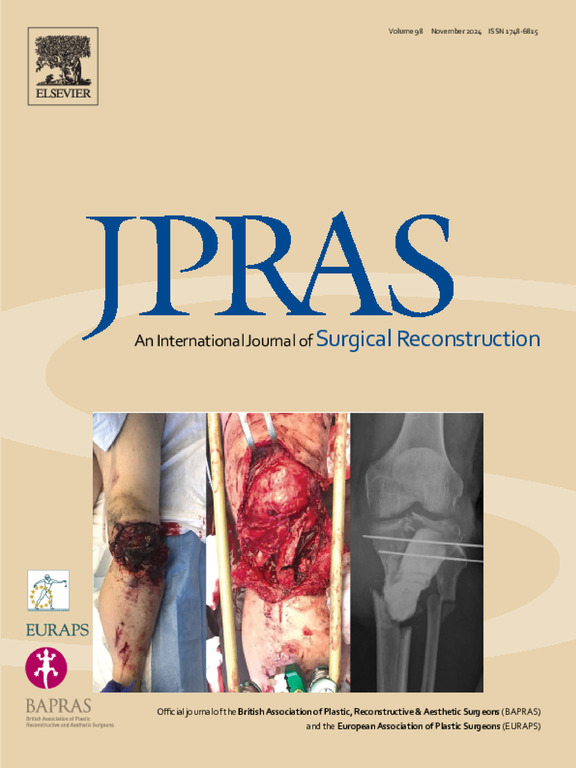A new surgical treatment of pincer nail deformity using artificial dermis
IF 2
3区 医学
Q2 SURGERY
Journal of Plastic Reconstructive and Aesthetic Surgery
Pub Date : 2025-06-03
DOI:10.1016/j.bjps.2025.05.034
引用次数: 0
Abstract
Background
Pincer nail deformity is an excessive transverse curvature of the nail plate. It often causes severe pain and reduces the patient's quality of life. Various surgical techniques have been reported for pincer nail deformity, but no studies have reported the use of artificial dermis to resolve the dead space on both sides of the distal phalanx after the deformed nail bed is elevated. We describe our new surgical method placing artificial dermis in these dead spaces, and we provide the results of our evaluation of the method’s effectiveness.
Methods
We examined the cases of the patients who underwent surgical treatment using artificial dermis for pincer nail deformity at our hospital between April 1, 2020, and March 31, 2024. The patients’ information was retrospectively reviewed from the medical records. In the surgery, we placed artificial dermis in the dead space on both sides of the distal phalanx. The change in nail curvature was evaluated using the height index (HI).
Results
A total of 19 toes of 11 patients were included. Postoperatively, the mean HI value was significantly improved from 64.8% to 12.9% (p<0.05). All 11 patients were relieved of the pain. No early postoperative complications and no recurrences were observed in the patients.
Conclusion
Our new method of placing artificial dermis in the dead space on both sides of the distal phalanx is a simple and effective treatment for pincer nail deformity.
人工真皮治疗钳甲畸形的新方法
背景:钳形甲畸形是指甲板横向曲率过大。它经常引起剧烈的疼痛,降低病人的生活质量。钳甲畸形的各种手术技术已被报道,但没有研究报道在变形的甲床升高后使用人工真皮来解决远端指骨两侧的死腔。我们描述了我们的新手术方法,将人工真皮放置在这些死腔中,并提供了我们对该方法有效性的评估结果。方法回顾性分析2020年4月1日至2024年3月31日在我院行人工真皮手术治疗钳甲畸形的病例。从医疗记录中回顾性地审查了患者的信息。在手术中,我们在远端指骨两侧的死腔内放置了人造真皮。使用高度指数(HI)评估指甲曲率的变化。结果11例患者共19个趾。术后平均HI值由64.8%显著提高至12.9% (p < 0.05)。11例患者均获得疼痛缓解。术后无早期并发症,无复发。结论在远端指骨两侧死腔内放置人工真皮是治疗钳甲畸形的一种简便有效的方法。
本文章由计算机程序翻译,如有差异,请以英文原文为准。
求助全文
约1分钟内获得全文
求助全文
来源期刊
CiteScore
3.10
自引率
11.10%
发文量
578
审稿时长
3.5 months
期刊介绍:
JPRAS An International Journal of Surgical Reconstruction is one of the world''s leading international journals, covering all the reconstructive and aesthetic aspects of plastic surgery.
The journal presents the latest surgical procedures with audit and outcome studies of new and established techniques in plastic surgery including: cleft lip and palate and other heads and neck surgery, hand surgery, lower limb trauma, burns, skin cancer, breast surgery and aesthetic surgery.

 求助内容:
求助内容: 应助结果提醒方式:
应助结果提醒方式:


